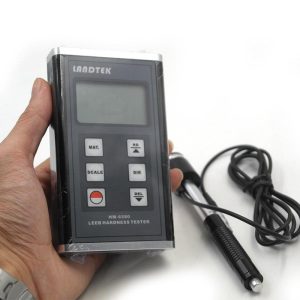The difference between different hardness standards of Leeb hardness tester
Leeb hardness tester is a common metal hardness testing instrument, which is widely used in the hardness testing of metal materials. The Leeb hardness tester can be used to express the test results in different hardness standards, which have different specifications and applications.
Different hardness standards use different hardness tester and test parameters in the test process, so in practical application, we should choose the appropriate hardness standard according to the nature of the material and the test purpose.

The following is the difference between different hardness standards of Leeb hardness tester:
HL standard: It is one of the earliest Leeb hardness standard, used to test steel materials. The hardness tester measures the elastic deformation depth of the steel surface under a certain drop weight and drop distance, in HL.
HB standard: This standard is used for testing cast iron, steel and non-iron metal materials. The weight and distance of the drop hammer of the durometer are slightly larger than that of HL, and the unit is HB.
The difference between different hardness standards of Leeb hardness tester
HR system: There are several different versions of this system, including HRB, HRC and HRA. HRB is used to test the hardness of mild steel, copper, aluminum and other materials, HRC is used to test the hardness of hard alloy, hardened steel and other materials, HRA is used to test the hardness of materials. The weight and distance of the drop hammer of the durometer are the same as that of HB system, and the unit is HR.
HV standard: used to test the hardness of metal and non-metal materials, often used to measure the hardness of thin plates and surfaces. This type of durometer uses a diamond indenter and is tested at small fall distances. The unit is HV.
HS standard: used to test the hardness of rubber, plastic, foam and other elastic materials. The durometer uses a conical indenter in HS.
σb standard: used to test the tensile strength of metal materials. This type of hardness tester measures the tensile strength of the sample by imprinting a specific geometry on the test sample and then performing a fracture tensile test. The unit is σb.
| Hardness standard | Applicable materials | Drop weight (kgf) | Fall distance (mm) | Key Features |
|---|---|---|---|---|
| HL | Steel and iron materials | 6、10、12.5、20、30、50 | 1.5、2.5、2.9、4.2、6、8 | One of the earliest Leeb hardness tests used for steel materials |
| HB | Cast iron, steel and non-iron metal materials | 10、20、30、50、100、150 | 2.5、2.5、2.5、2.5、2.5、2.5 | Used to test the hardness of cast iron, steel and non-iron metal materials |
| HRB | Mild steel, copper, aluminum and other materials | 60、100、150 | 1.27、1.5875、2.54 | Used to test the hardness of mild steel, copper, aluminum and other materials |
| HRC | Hard alloy, hardened steel and other materials | 60、100、150 | 1.27、1.5875、2.54 | Used for testing Used to test the hardness of hard alloy, hardened steel and other materials |
| HRA | Material with high hardness | 60、100、150 | 1.5875、2.5、5 | Used for testing materials with high hardness |
| HV | Metallic and non-metallic materials | 10、20、30、50、100、150 | 0.01、0.02、0.025、0.05、0.1、0.2 | Used for measuring sheet and surface hardness |
| HS | Rubber, plastic, foam and other elastic materials | – | 0.05、0.1、0.2 | Used to test the hardness of elastic materials |
| σb | Metal material | – | – | The tensile strength of the specimen is measured by imprinting a specific geometry on the test sample and then performing a fracture tensile test |
Although the hardness tester and test parameters used in the test process are different for different hardness standards, they are all common metal hardness test methods. The appropriate hardness standard should be selected according to the test requirements and material characteristics.
